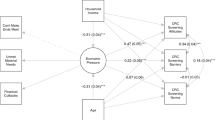Abstract
Cancer is the second leading cause of death in the U.S. and its economic cost is very high. The objective of this study is to analyze the socioeconomic and demographic factors that are related to the willingness to pay (WTP) for cancer prevention. Data from an experimental module in the 2002 Health and Retirement Study (HRS) were used to identify WTP differences across different population subgroups. Respondents were asked whether they were willing and able to pay different dollar amounts per month for a new cancer prevention drug. Years of age were negatively related to WTP whereas income and the probability of develo** cancer were positively related to WTP. Risk-relevant numeracy skills were positively related to self-assessed cancer risk, which may suggest that adults with poor numeracy skills underestimate their cancer risk. This has consequences not only on the relative perceived value of different cancer treatments across different population subgroups but also on perceived value as captured by WTP.
Similar content being viewed by others
References
American Cancer Society: (2008) Cancer facts & figures 2007. American Cancer Society, Atlanta, Georgia
Bateman I. J., Langford I. H., Jones A. P., Kerr G. N. (2001) Bound and path effects in double and triple bounded dichotomous choice contingent valuation. Resource and Energy Economics 23(3): 191–213
Cameron T. A. (1988) A new paradigm for valuing non-market goods using referendum data: Maximum likelihood estimation by censored logistic regression. Journal of Environmental Economics and Management 15: 355–379
Diener A., O’Brien B., Gafni A. (1998) Health care contingent valuation studies: A review and classification of the literature. Health Economics 7: 313–326
Frew E., Wolstenholme J. L., Whynes D. K. (2001) Willingness-to-pay for colorectal cancer screening. European Journal of Cancer 37: 1746–1751
Hanneman W. M., Kanninen B. (1999) The statistical analysis of discrete-response CV data. In: Batemen I., Willis K. (eds) Valuing environmental preferences: Theory and practice of the contingent valuation method in the US, EU and develo** countries. Oxford University Press, New York, pp 302–441
Hannemann W. M., Loomis J., Kanninen B. (1991) Statistical efficiency of double bounded dichotomous choice contingent valuation. American Journal of Agricultural Economics 73: 1255–1263
Health and Retirement Study (2006) 2002 Core Final, Version 2.0 (June 2006). Institute for Social Research, University of Michigan. http://hrsonline.isr.umich.edu/meta/2002/core/desc/h02dd.pdf. Accessed 14 Apr 2009.
Khwaja A., Sloan F., Salm M. (2006) Evidence on preferences and subjective beliefs of risk takers: The case of smokers. International Journal of Industrial Organization 24: 667–682
Klose T. (1999) The contingent valuation method in health care. Health Policy 47: 97–123
Krupnick A., Alberini A., Cropper M., Simon N., O’Brien B., Goeree R., Heintzelman M. (2002) Age, health and willingness to pay for mortality risk reductions: A contingent valuation study of Ontario residents. Journal of Risk and Uncertainty 24: 161–186
Leacock, C. P. (2006). Getting started with the health and retirement Study. Institute for Social Research, University of Michigan. http://hrsonline.isr.umich.edu/docs/dmgt/IntroUserGuide.pdf. Accessed 14 Apr 2009.
Lee C. P., Chertow G. M., Zenios S. A. (2009) An empiric estimate of the value of life: Updating the dialysis cost-effectiveness standard. Value in Health 12(1): 80–87
National Cancer Institute (2006). 2006 Fact book. National Cancer Institute. http://obf.cancer.gov/financial/attachments/06Factbk.pdf. Accessed 14 Apr 2009.
National Cancer Institute (2007). The nation’s investment in cancer research: A plan and budget proposal for fiscal year 2008. National Cancer Institute. http://plan.cancer.gov/plan_overview.shtml. Accessed 14 Apr 2009.
National Cancer Institute (2009a). The nation’s investment in cancer research: An annual plan and budget proposal for fiscal year 2010. National Cancer Institute. http://plan.cancer.gov/pdf/nci_2010_plan.pdf. Accessed 14 Apr 2009.
National Cancer Institute (2009b). Surveillance epidemiology, and end results (SEER) program devcan database. http://www.seer.cancer.gov. Accessed 16 May 2010.
O’brien B. J., Goeree R., Gani A., Torrance G. W., Pauly M. V., Erder H., Rusthoven J., Weeks J., Cahill M., LaMont B. (1998) Assessing the value of a new pharmaceutical: A feasibility study of contingent valuation in managed care. Medical Care 36(3): 370–384
Ofstedal, M. B., Fisher, G. G., & Herzog, A. R. (2005). Documentation of cognitive functioning measures in the health and retirement study. HRS Documentation Report DR-006 (March 2005). Institute for Social Research, University of Michigan. http://hrsonline.isr.umich.edu/docs/userg/dr-006.pdf. Accessed 14 Apr 2009.
Peters E., Hibbard J., Slovic P., Dieckmann N. (2007) Numeracy skill and the communication, comprehension, and use of risk-benefit information. Health Affairs 26: 741–748
Smith V. K., Taylor D. H. Jr., Sloan F. A. (2001) Longevity expectations and death: Can people predict their own demise. The American Economic Review 91(4): 1126–1134
Sttalhammar N.-O. (1996) An empirical note on willingness to pay and starting point bias. Medical Decision Making 16: 247
Viscusi W. K. (1993) The value of risks to life and health. Journal of Economic Literature 31(4): 1912–1946
Viscusi W. K., Zeckhauser R. J. (2003) Sacrificing civil liberties to reduce terrorism risks. The Journal of Risk and Uncertainty 26(3): 99–120
Wagner T. H., Hu T., Dueñas G. V., Kaplan C. P., Nguyen B. H., Pasick R. J. (2001) Does willingness to pay vary by race/ethnicity? An analysis using mammography among low-income women. Health Policy 58: 275–288
Watson V., Ryan M. (2007) Exploring preference anomalies in double bounded contingent valuation. Journal of Health Economics 26: 463–482
Whitehead J. C. (2002) Incentive incompatibility and starting-point bias in iterative valuation questions. Land Economics 78(2): 285–297
Author information
Authors and Affiliations
Corresponding author
Rights and permissions
About this article
Cite this article
Milligan, M.A., Bohara, A.K. & Pagán, J.A. Assessing willingness to pay for cancer prevention. Int J Health Care Finance Econ 10, 301–314 (2010). https://doi.org/10.1007/s10754-010-9082-2
Received:
Accepted:
Published:
Issue Date:
DOI: https://doi.org/10.1007/s10754-010-9082-2




